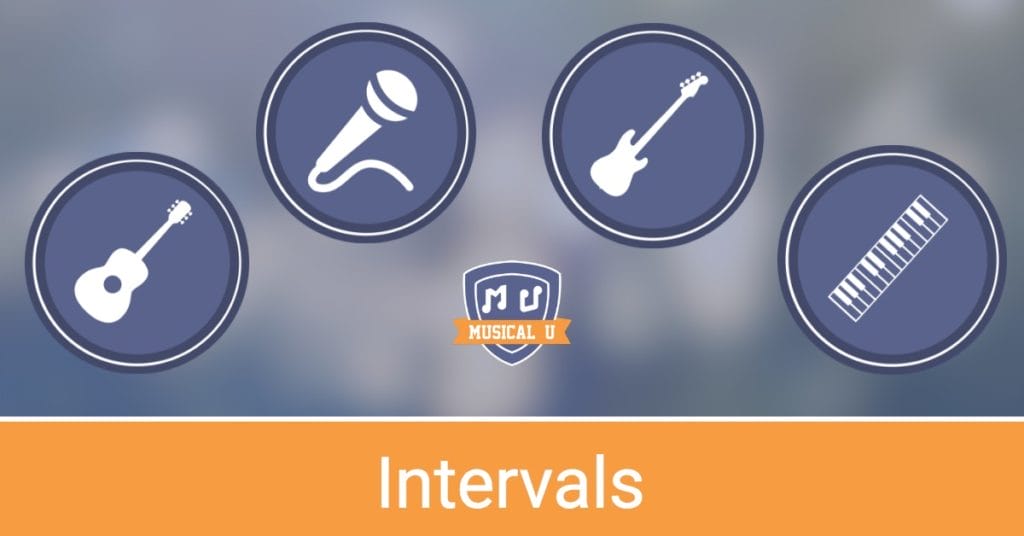What would you say is the most fundamental musical element to learn on your instrument? Scales? Chords? Think again.
Let’s start with the lowly interval – simply the space between any two given pitches. Scales, melodies, chord progressions all happen when we move from one note to another.
Interval training is often considered the backbone of ear training – and for good reason. How can we comprehend the rich possibilities of melodies and harmonies without a strong perception of how one note relates to another?
Yet often traditional interval training can be difficult, dry, and, well… boring.
As Christopher Sutton described in About The Ear Training Trap, unless you relate your ear training to your actual musical life, it’s easy to loose enthusiasm. The solution is to relate your ear training and music theory to playing your instrument.
In this month’s Instrument Packs Musical U’s Resident Pros for guitar, piano, and bass show how each one of these instruments has a unique relationship to intervals. But beyond basic fingering patterns, the creative minds of our Resident Pros reveal the musical magic that brings intervals to life.
In other words, the intervals are released from their theoretical cages and we experience just how beautiful, mysterious, and powerful they behave in the wild:
Bass
Intervals naturally inhabit nearly all musical environments, including the diatonic scale. Resident Pro Steve Lawson demonstrates how to explore your the inner workings of the major scale on your bass fretboard:
Including:
- Intervals and Diatonic Music - How we think about intervals in relation to understanding and playing in a specific key.
- Several patterns and exercises for navigating all the notes in any major key.
- Intervals and Harmony - How the interval of a third can allow us to play new patterns in any key, and give us access to extended arpeggio shapes.
- How to move fluidly from any note in a key to any other note.
- Beautiful backing tracks in different keys and styles to put it all in a musical context.
Intervals are inherent in the basic structure of the bass as an instrument, as well as the diatonic scale that underlies so much of our music. Learning them with Steve will help you bring them out creatively and grow your musical ears.
Piano
Resident Pro Sara Campbell shows how the structure of the piano keyboard – that ultimate music interface – reflects the inner intervallic architecture of the diatonic scale, and makes finding and remembering intervals a breeze:
Including:
- Major Scale Exercise – One magical exercise that incorporates all major, minor, and perfect intervals within the major diatonic scale.
- Finding Fifths on the Keyboard – How to quickly find and practice one of the most important intervals in tertian harmony.
- Interval Reading Trick – Here’s a super easy way to recognize intervals on the staff. Once you learn these patterns, it will be much easier for you to quickly read intervals.
- Jazzy MP3 backing tracks which bring your interval practice to life.
See how learning simple intervals can create beautiful, even complex-sounding music quickly, as well as how the piano itself lends itself to easy tricks for interval practice.
Guitar
This month is all about intervals, and Resident Pro Dylan Welsh has prepared a ton of material for you to dive into! If you’ve explored the many learning materials available on Musical U, you’ve probably spent a lot of time with intervals. In this month’s resource pack, Dylan will be showing you some exercises and tips for understanding, finding, and using intervals on the guitar itself:
Including:
- The universal shapes for every single interval as they lay out along the guitar fretboard/how to find every interval on the guitar.
- A melodic interval exercise, within the G major scale.
- A harmonic interval exercise in the key of G major.
- Exercises, MP3s examples and backing tracks, and a PDF with pages of tab and notation to take you on a complete intervallic tour of G major.
- Tips on transposing these exercises into all other keys.
Take a giant step to fretboard freedom, all the while enjoying musical-sounding exercises with great backing tracks, with this month’s Intervals Resource Pack.
Coming up next month…
It began when African scales and rhythms met European music, instruments and tunings. While this musical meld began in the midst of the pain and suffering of racial persecution, what emerged was to become the basis of nearly all popular music in the world today.
The Blues went on to prove that feeling bad can sound real good! Dig into what makes this genre the foundation of jazz, rock ‘n’ roll, R&B, country, and just about every other popular genre today.
Next month we’ll learn how the language of the blues translates into the language of your instrument.
Interested in getting access to these resources and much more, with an Instrument Pack membership? Just choose that option during checkout when you join Musical U, or upgrade your existing membership to get instant access!







